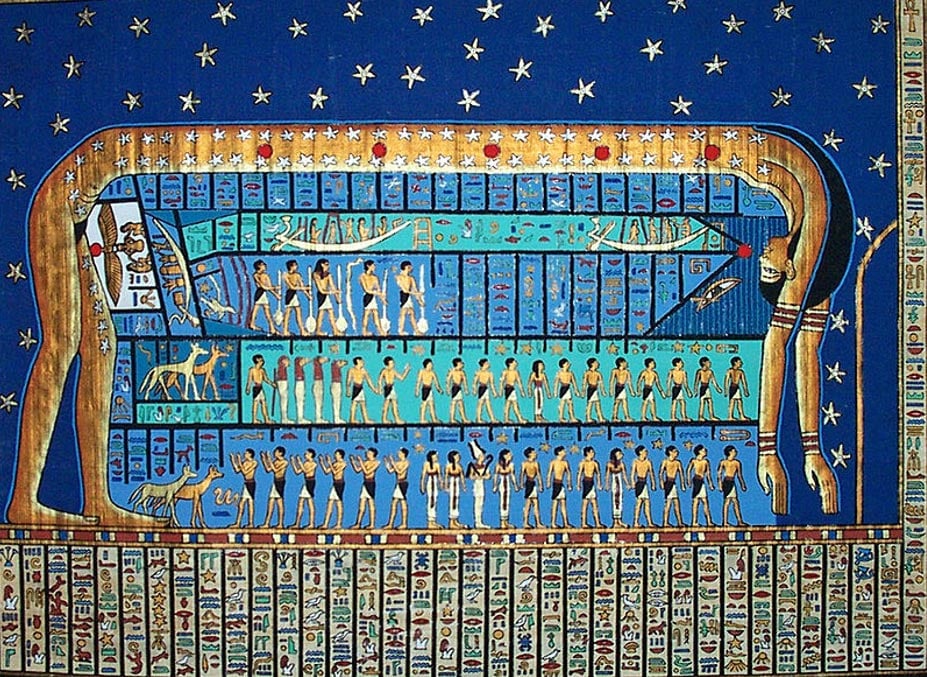Ancient Egyptians Discovered the Period of Algol Three Millennia Before Previously Thought and Used the Information for Divination
There have long been theories that the mythological texts of the ancient Egyptians contain scripture related to astronomical phenomena. It is also known that as part of their cosmology, the Egyptians created calendars depicting favorable and unfavorable days, however the basis for these calendars was not always obvious. Now, a study of the best preserved of the Egyptian calendars, the Cairo Calendar (CC), shows that predictions may have been based on the periods of the binary star Algol and the moon.
The Ancient Egyptian year contained 12 months of 30 days and five additional “epagomenal” (extra) days. One example of an ancient Egyptian calendar is the Cairo Calendar (CC), which was created between 1244 - 1163 BC and contains scripture related to daily predictions in the form of mythological events. Within the CC there are three predictions for each day. For some time, there has been a belief that the CC was based on astronomical features.
Sebastian Porceddu of the University of Helsinki and co-author of the study, asserts that the results of their statistical analysis of the religious text are groundbreaking in that:
“Until now, there were only conjectures that many of the mythological texts of the Cairo Calendar describe astronomical phenomena. We can now unambiguously ascertain that throughout the whole year the actions of many deities in the Cairo Calendar are connected to the regular changes of Algol and the Moon.”
According to Phys.org, the current research of the CC also provides concrete evidence that the variable star, Algol, and its period were known and used for divination about three millennia earlier than was previously thought. Before the evidence provided in this study, it was believed that Algol was the second variable star discovered, and was first document in 1669 by Montanari.

Location of Algol in the constellation Perseus. (CC BY SA 3.0)
Lauri Jetsu and Sebastian Porceddu wrote: “We have presented evidence that the 2.85-day period in the lucky prognoses of CC is equal to that of the eclipsing binary Algol during this historical era.”
- The Liber Linteus: An Egyptian Mummy Wrapped in a Mysterious Message
- Magic and superstition in ancient Egypt
- Star charts reveal how ancient Egyptians planned to navigate the sky after death
- Perseus: Powerful Demigod wth Mighty Weapons
Furthermore, the researchers assert that “Algol was represented as Horus and thus signified both divinity and kingship. The texts describing the actions of Horus are consistent with the course of events witnessed by any naked eye observer of Algol.”

Excerpt of the Cairo Calendar. Inside the superimposed rectangle is the hieratic writing for the word ‘Horus.’ (Lauri Jetsu)
Algol makes up a pair of stars and is commonly known as the “demon star.” It is part of the constellation Perseus. The variable star and its partner share a center of gravity, and when they align every 2.85 days one of the stars eclipses the other – creating a dimmed appearance of the star.
Algol received its name as the demon star in honor of the mythological creature the Gorgon Medusa. The word Algol came from the Arabic word Ra's al-Ghul, meaning “the Demon’s Head.” Algol is also known as a variable star for the waxing and waning effect of the eclipses – which may have been associated with Medusa’s blinking eye to the ancient Greeks.

Depiction of the constellation Perseus with Medusa’s head from 1690. (Public Domain)
Also contained within the CC are the importance of the periods of the moon for luck. Jetsu and Porceddu believe that they have uncovered the god associated with this celestial body as well: “We show that the actions of Seth were connected to this period, which also strongly regulated the times described as lucky for Heaven and for Earth.”
In the CC, the brightest appearances of both Algol and the moon were seen as fortuitous, while the fainter appearance foretold inauspicious days. In comparison to other horoscopes, for the ancient Egyptians the effects of the heavenly spheres were seen as affecting all people.

Set (Seth) and Horus adoring Ramesses. (Public Domain) The current study shows that the moon may have been represented by Seth and the variable star Algol by Horus in the Cairo Calendar.
Lauri Jetsu understands that the study may not be well-received by all who read it:
"I would have serious doubts, if someone claimed, for example, that the Bible contains information about water in Mars. We claimed that Ancient Egyptian religious texts contain astrophysical information about Algol. It was no surprise to us that there were, and there still are, sceptics."
Featured Image: The ancient Egyptian sky goddess, Nut, arching over the earth. The human figures represent stars and constellations. Source: Public Domain
By: Alicia McDermott



















